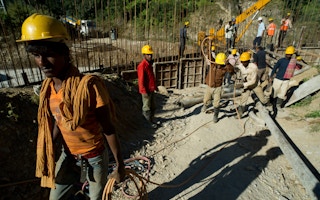Earlier this year, the president of Colombia announced that, as part of the country’s efforts to shift to a sustainable economy and fight climate change, it will not approve any new oil and gas exploration in its lands or waters.
This is a major shift for a country in which fossil fuels make up 55 per cent of its exports. But how will Colombia provide for communities whose livelihoods were previously tied to fossil fuels? Only by being proactive can policymakers ensure a “just transition” that leaves no one behind.
Although countries such as Saudi Arabia and the United States may dominate the headlines when it comes to global oil and gas production, about half of the world’s oil and gas is actually produced by countries like Colombia that are middle-income developing countries (defined by the World Bank as those with annual per capita gross national income between US$1,036 and US$12,535).
Preparing for the transition away from fossil fuels will be essential for these middle-income countries to prevent the most dangerous impacts of climate change and minimize harm to vulnerable populations. Moreover, it may provide opportunities to shift societies in a more equitable direction by expanding sectors that provide greater long-term economic benefits.
Although fossil fuel workers often get paid well compared with other jobs, that income is rarely distributed equitably within their communities. For example, in Colombia, levels of poverty were found to be higher in coal-mining regions such as Guajira or Chocó relative to the rest of the country.
“
Preparing for the transition away from fossil fuels will be essential for these middle-income countries to prevent the most dangerous impacts of climate change and minimize harm to vulnerable populations.
Yet despite these potential benefits, shrinking global oil demand — crucial if we are to limit global warming to 1.5 degrees Celsius — will present significant challenges for these countries. Many of these countries disproportionately rely on fossil fuels compared with other sectors to fund their governments, which makes them especially vulnerable to sudden fluctuations in price. Declining revenues and market volatility can have unfortunate consequences for those who can least afford it. For example, after the 2014 oil price crash, Mexico cut public spending by US$8.5 billion, affecting services including transportation and education.
In addition, the decline of the oil and gas sector could also seriously impact populations that are already vulnerable: the contract-based oil and gas workers without union protections; the food vendors and others in the informal economy (often women) who cater to fossil fuel workers; the government employees who may lose their jobs as budgets dry up. Middle-income countries also will have fewer resources to transition away from fossil fuels and build clean energy economies.
Replacing fossil fuel income
New research from World Resources Institute suggests several ways that policymakers can get ahead of the challenges of shifting away from fossil fuels. First, middle-income countries should engage in proactive, long-term planning to understand who and what will be impacted by the decline of oil and gas production, and to work closely with a wide range of stakeholders to ensure that they will all benefit from the new economy that replaces it.
Colombia’s Long-term Climate Strategy includes a section on just transition, and specifically notes that employment impacts on different groups based on location, gender, ethnicity, and other factors must be measured and monitored.
Second, they must pursue economic diversification now to jumpstart new industries and expand promising sectors that can collectively replace the previous income from fossil fuels. In the case of Colombia, the government has already proposed that the tourism and agriculture sectors could fill the gap, though questions remain about whether revenue would be sufficient to fully replace this funding.
Third, these countries must dedicate adequate domestic funding to support this transition. And lastly, richer countries and international financial institutions must step up to provide funding and technical support to help middle-income countries through this transition.
Although there are still many unanswered questions about how Colombia will proceed and which economic sectors hold the most potential to replace oil and gas, the country is moving in the right direction.
If we are to limit global warming to 1.5 degrees Celsius and ensure that national economies can weather a major shift in the sources of their power and revenue, other middle-income developing countries should follow Colombia’s example and prepare for the transition away from fossil fuels. It’s a big task, but the sooner countries start the easier — and likely cheaper — it will be, and the sooner they will reap the rewards.
This story was published with permission from Thomson Reuters Foundation, the charitable arm of Thomson Reuters, that covers humanitarian news, climate change, resilience, women’s rights, trafficking and property rights. Visit https://www.context.news/.










